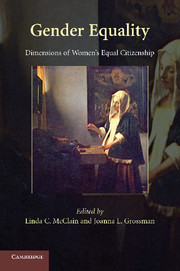Book contents
- Frontmatter
- Contents
- Contributors
- Acknowledgments
- Gender Equality
- Introduction
- PART I CONSTITUTIONAL CITIZENSHIP AND GENDER
- PART II POLITICAL CITIZENSHIP AND GENDER
- PART III SOCIAL CITIZENSHIP AND GENDER
- PART IV SEXUAL AND REPRODUCTIVE CITIZENSHIP
- PART V GLOBAL CITIZENSHIP AND GENDER
- 17 Women's Unequal Citizenship at the Border: Lessons From Three Nonfiction Films About the Women of Juárez
- 18 Domestic Violence, Citizenship, and Equality
- 19 On the Path to Equal Citizenship and Gender Equality: Political, Judicial, and Legal Empowerment of Muslim Women
- 20 Gender and Human Rights: Between Morals and Politics
- Suggested Readings
- Index
- References
20 - Gender and Human Rights: Between Morals and Politics
Published online by Cambridge University Press: 05 August 2012
- Frontmatter
- Contents
- Contributors
- Acknowledgments
- Gender Equality
- Introduction
- PART I CONSTITUTIONAL CITIZENSHIP AND GENDER
- PART II POLITICAL CITIZENSHIP AND GENDER
- PART III SOCIAL CITIZENSHIP AND GENDER
- PART IV SEXUAL AND REPRODUCTIVE CITIZENSHIP
- PART V GLOBAL CITIZENSHIP AND GENDER
- 17 Women's Unequal Citizenship at the Border: Lessons From Three Nonfiction Films About the Women of Juárez
- 18 Domestic Violence, Citizenship, and Equality
- 19 On the Path to Equal Citizenship and Gender Equality: Political, Judicial, and Legal Empowerment of Muslim Women
- 20 Gender and Human Rights: Between Morals and Politics
- Suggested Readings
- Index
- References
Summary
Introduction
The phenomenon of globalization and its attending imaginary representations of one world raise issues regarding legal norms that are as vast as they are complex. The premise of global integration raises implications for the women's movement and its legal claims and has necessitated a rethinking about gender and justice. The issue of women's equality has undoubtedly assumed a place of prominence in the debates on globalization and international law and, in the context of globalization paradigms, has motivated efforts to develop universal norms to guide the conduct of public life as well as private realms.
The project to improve the condition of women has assumed multiple forms, from local grassroots organizing to national and international movements. Women's organizations and human rights groups have frequently relied upon legal approaches and rights-based claims. Feminist scholars have proposed gendered theories of citizenship and human rights as a means to advance norms of women's equality within an international framework. Indeed, the degree to which the international community incorporates legal norms of gender equality provides a standard by which to take stock of the progress made toward human rights generally.
The advances made in adopting international legal standards that benefit women are noteworthy precisely because they have been registered in an environment subject to the constraints of market mechanisms so often detrimental to the condition of women and under circumstances of ethnic tensions, political violence, and foreign invasion.
- Type
- Chapter
- Information
- Gender EqualityDimensions of Women's Equal Citizenship, pp. 409 - 430Publisher: Cambridge University PressPrint publication year: 2009
References
- 1
- Cited by



